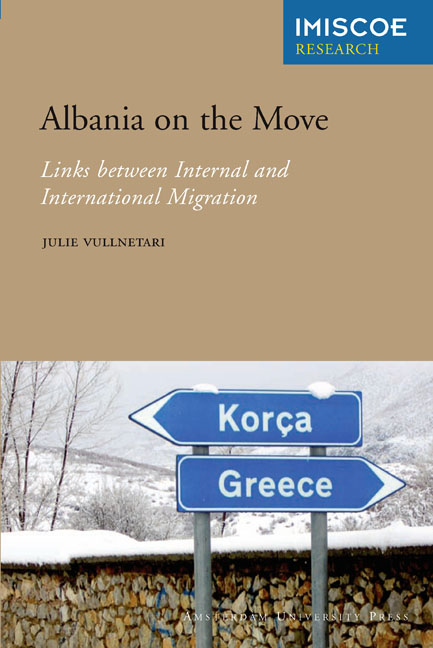Book contents
- Frontmatter
- Dedication
- Contents
- List of Tables, Figures and Photos
- Abbreviations
- Preface
- 1 Introduction
- 2 The Migration-Development Nexus
- 3 Albanian Migration and Development
- 4 Leaving Home: Migration Patterns and Dynamics
- 5 Across the Border: Migrants in Thessaloniki
- 6 Family, Migration and Socio-economic Change
- 7 Migration and Albania's Dynamic Transformation
- 8 Conclusions and Recommendations
- Notes
- References
- Other IMISCOE Titles
8 - Conclusions and Recommendations
Published online by Cambridge University Press: 19 January 2021
- Frontmatter
- Dedication
- Contents
- List of Tables, Figures and Photos
- Abbreviations
- Preface
- 1 Introduction
- 2 The Migration-Development Nexus
- 3 Albanian Migration and Development
- 4 Leaving Home: Migration Patterns and Dynamics
- 5 Across the Border: Migrants in Thessaloniki
- 6 Family, Migration and Socio-economic Change
- 7 Migration and Albania's Dynamic Transformation
- 8 Conclusions and Recommendations
- Notes
- References
- Other IMISCOE Titles
Summary
Having ended the previous chapter on a highly critical note for policymaking, I now step back and broaden my gaze to encompass the totality of my research findings in order to review and re-evaluate them against the aims I set for myself at the beginning of the book. I first revisit the interlinkages between internal and international migration and the impact of these dynamics on the development process in Albania. In so doing, I draw attention to some policy recommendations flowing from this discussion. I then highlight the limitations and strengths of my work, including its theoretical contribution, before closing with suggested potential avenues for further research. I use italics throughout this chapter to emphasise the key findings and policy recommendations.
Dynamics of internal and international migration in development processes
At the start of my research, I set out to find the ways in which internal and international migration are linked together, from the perspective of Albania as an origin country. From the beginning, I was faced with a double challenge. On the one hand, the theoretical and empirical literature focusing specifically on these links was rather limited, particularly from a development perspective. On the other hand, this was compensated for by a vast extant body of knowledge on internal and international migration, as well as their separate – yet multiple – links with development processes in various parts of the world. Although not vast, the literature on Albanian migration and development is growing fast; yet again, the two migration types are rarely linked to each other and to development processes in the country. My research findings have brought many new insights for understanding how migration – internal and international – interacts with development processes, but they have also confirmed some of the existing results from this wide body of literature.
Thus, the first major conclusion is that both migration types are closely interlinked in the way they affect development in poor origin countries like Albania. Consequently, in order to achieve a comprehensive understanding of migrants’ lives, as well as the social transformations that migration is part of, it is important – indeed necessary – for any analysis to integrate both migration types.
- Type
- Chapter
- Information
- Albania on the MoveLinks between Internal and International Migration, pp. 233 - 244Publisher: Amsterdam University PressPrint publication year: 2012



